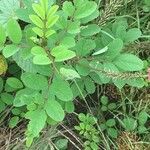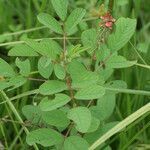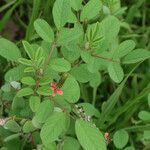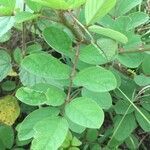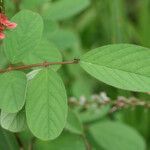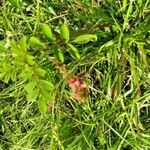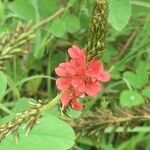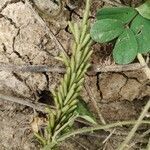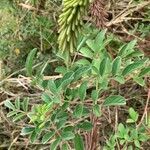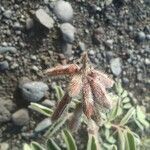Erect and spreading or prostrate annual herb or subshrub to 1.5 m high; young stems ridged, white and green or dark brown, hirsute with moderately dense to dense, spreading, unequally biramous hairs. Leaves pinnate, to 8 cm long, with 3–9 (–11) leaflets; stipules subulate, 5–10 (–14) mm long, pubescent; petiole 4–16 mm long; rachis furrowed; leaflets opposite, discolorous, elliptic or obovate, 6–30 (–45) mm long, 4.5–17 (–25) mm wide, apex obtuse and shortly mucronate. Inflorescences 6–20 (–34) cm long, longer than leaves; peduncle 2–7 (–8.5) cm long; bracts subulate or narrowly triangular, 1.5–4 (–6.5) mm long; pedicels to 1.5 mm long; flowers red or deep pink (rarely yellow). Calyx 3–6.5 mm long; lobes unequal, longer than the calyx tube, clothed with spreading hairs. Standard ovate, obovate or orbicular, 4–5 mm high, 3–4 mm wide. Wings narrowly obovate or spathulate, 4.3–5.2 mm long, 1.1–1.9 mm wide. Keel 4.7–5.2 mm long, 1.3–2.1 mm deep; apex acute to rounded; lateral pockets 0.6–1 mm long. Staminal tube 3.3–4.5 mm long, colourless. Ovary densely hairy. Pods deflexed, terete or shortly cylindrical, 10–20 (–26) mm long, 2–3.5 mm deep, red-brown, densely covered in stiff, spreading, brown hairs; apex shortly pointed; endocarp spotted. Seed 6–9, cuboid.
Erect or spreading annual up to 1.5 m. tall; stems cylindrical or slightly ridged, stiffly brownish or, occasionally, white pilose.. Stipules linear-setaceous, up to 1 cm. long; rhachis pilose, up to 9 cm. long, including a petiole of up to 2 cm., prolonged up to 13 mm. beyond the lateral leaflets; stipellae not visible; petiolules 2 mm. long; leaflets 5–7 or rarely 9, elliptic-oblong, up to 40 mm. long and 25 mm. wide, the terminal rather longer than the lateral, pilose on both surfaces.. Racemes dense, many-flowered, hirsute, in all 20 or 30 cm. long, including a peduncle which is more than 25 mm. long but usually shorter than the floriferous part; bracts linear-lanceolate, up to 5 mm. long, caducous; pedicels ± 1 mm. long, reflexed in fruit.. Calyx stiffly brown hirsute, ± 4 mm. long, divided almost to the base into linear-setaceous lobes.. Corolla white pubescent outside, brick-red or rose, the standard the same colour as the wings.. Stamens ± 4 mm. long.. Pod straight, rather tetragonal, with well-developed sutures, 12–20 mm. long, ± 2 mm. wide and thick, hirsute, many of the hairs, especially the dorsal ones, usually brown; endocarp strongly spotted.. Seeds 6–9, cuboid, angular, strongly pitted.. Fig. 45/1–14.
Herbaceous, erect, densely and softly hairy; branches angular; leaves short-petioled, 4-6-jugate, the common petiole gland-stipelled; leaflets elliptic-oblong, subobtuse, mucronulate, villous on both sides, the terminal petioled; stipules setaceo-subulate, long; racemes subspicate, on long, hirsute peduncles, densely many-flowered; bracts minute; calyces hirsute, the segments subulate-acuminate; legumes short, turgid, mucronate, deflexed, densely hirsute, few-seeded.
A shrub. It can grow 1 m tall. The stems have a rusty brown coating. The leaves are 3-10 cm long and have 5-9 leaflet stalks. The leaflets are opposite and 1.5-3.5 cm long by 0.7-2 cm wide. The pod is 1.5-2 cm long by 2-2.5 mm wide. There are 6-9 seeds.
